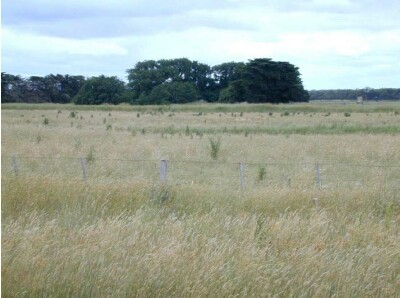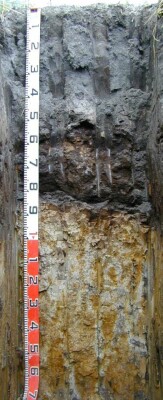GHF04e
Location: Bessiebelle
Australian Soil Classification: Parapanic, Humosesquic, Semiaquic, PODOSOL
General Landscape Description: Level Plain
Site Description: Flat
Land Unit: Strathdownie
Geology: Quaternary lacustrine
General Land Unit Description:
This land unit comprises the Quaternary lacustrine geology south of the Glenelg River. The lacustrine deposits include lagoonal, swamp and local colluvial deposits formed in low-lying wetlands and depressions between stranded beach ridges. Parent material in this land unit comprises of sand, silt, sandy clay, peat, marl and freshwater limestone, occurring in relatively unconsolidated forms.
The soils are variable throughout this land unit due to varying depositional environments. A common soil type is a strong texture contrast soil (Chromosol) commonly with a bleached A2 horizon and a mottled subsoil (indicative of impeded internal drainage). The sandy topsoil can be very deep in some soils. Vertosols are also common on the plains and swales in between the dunes. Podosols occur on the flats as well as on the dunes and that may have been mapped as part of this land unit due to restrictions of scale. Many of the soils are poorly drained and exhibit signs of a perched watertable.
1.5 year old Eucalyptus globulus plantation on ex-agricultural land. This plot is in a slight depression, trees outside the plot in a drainage line are dead. There is no surface soil cracking as observed in plots 3 and 4. A second pit was dug across the mound, and half of the coffee rock layer had been shattered/ripped. Roots had penetrated the shattered portion of this layer, but not into the cemented lower portion of this layer.

Soil Profile Morphology
Surface
| A1 | 0-30 cm | Very dark grey (10YR3/1) loamy sand; single grain structure; very weak consistence when moist; common medium roots; gradual and smooth transition to:
|  |
| A2 | 30-45 cm | Grey (10YR5/1) sand; single grain structure; loose consistence when moist; common very fine roots; clear and wavy transition to:
| |
| Subsoil
| |||
| Bhs | 45 – 85 cm | Dark reddish brown (5YR2.5/2) unable to assess field texture and macroporosity due to pan; massive structure; strong consistence when moist; moderately cemented continuous massive organic pan; no roots observed; abrupt and wavy transition to:
| |
| B2 | 85 – 150 cm | White (10YR8/1) with many coarse distinct brownish yellow (10YR6/8) mottles, medium clay; weak polyhedral structure (50-100 mm) parting to weak polyhedral structure (10-20 mm); weak consistence when moist; common very fine macropores; areal porosity 0.05%; no roots observed; gradual and smooth transition to:
| |
| B3 | 150 – 170 cm | White (10YR8/1) with many very coarse distinct brownish yellow (10YR6/8) and reddish brown (5YR5/4) mottles, sandy clay; weak polyhedral structure (20-50 mm); weak consistence when moist; few very fine macropores; areal porosity 0.03%; no roots observed.
| |
| 170 – 270 cm | Grey and yellow-brown sandy clay, no roots observed.
| ||
| 270 – 390 cm | Grey heavy clay with yellow mottles, no roots observed.
| ||
Soil Profile Characteristics:
- | pH | Salinity | ||
Surface Soil (A1 horizon) | Very Strongly Acid | Very Low | Non-Sodic | None |
Subsoil (B2 Horizon) | Moderately Acid | Low | Sodic | None |
Deeper Subsoil (150-170 cm) | Slightly Acid | Low-Medium | Sodic | None |
Chemical and Physical Analysis:
Horizon | Horizon Depth (cm) | pH (water) | pH (CaCl2) | EC dS/m | Exchangeable Aluminium ppm | Exchangeable Acididty meq/100g | Exchangeable Cations | Coarse Sand (0.2-2.0 mm) % | Fine Sand (0.02-0.2 mm) % | Silt (0.002-0.02 mm) % | Clay (<0.002 mm) % | Field Capacity % w/w | Wilting Point % w/w | |||
Ca | Mg | K | Na | |||||||||||||
meq/100g | ||||||||||||||||
A1 | 0-30 | 4.6 | 3.7 | 0.05 | 27 | 2.2 | 0.46 | <0.05 | 0.21 | 50 | 38 | 7 | 6 | 11.4 | 5.4 | |
A2 | 30-45 | 4.9 | 4.0 | <0.05 | 10 | 0.46 | 0.11 | <0.05 | 0.13 | 51 | 40 | 8 | 5 | 5.8 | 1.5 | |
Bhs | 45-85 | 5.3 | 4.7 | 0.13 | 130 | 16 | 0.66 | 0.45 | <0.05 | 0.60 | 53 | 31 | 6 | 6 | 9.8 | 4.1 |
B2 | 85-150 | 5.9 | 5.2 | 0.33 | <10 | 7.4 | 1.0 | 4.1 | <0.1 | 1.4 | 40 | 22 | 5 | 36 | 23.6 | 13.3 |
B3 | 150-170 | 6.1 | 5.6 | 0.29 | <10 | 5.1 | 0.7 | 2.7 | 0.1 | 0.9 | ||||||
Profile Described By: Ian Sargeant and Paul Feikema (December 2000)


